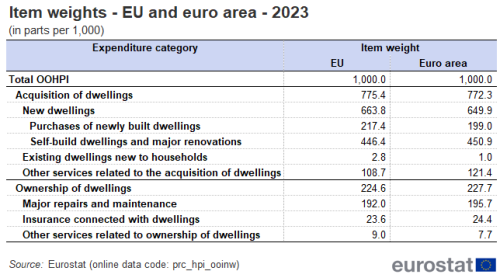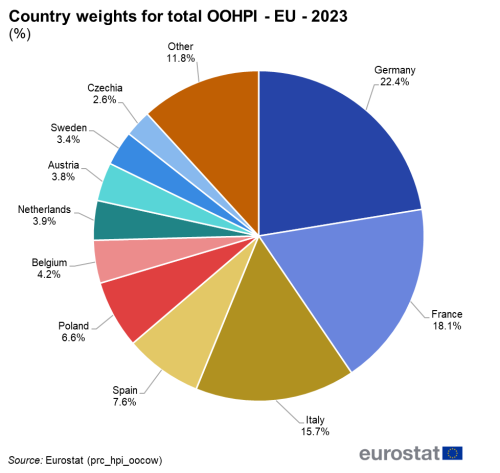Housing price statistics - owner-occupied housing price index
Data extracted on 4 April 2024
Planned article update: 9 July 2024
Highlights
In the fourth quarter of 2023, owner-occupied housing prices in the EU increased by 4.1% compared with the same quarter of 2022.
In the fourth quarter of 2023, the highest annual rate of change among all categories covered by the owner-occupied housing price index for the European Union was recorded for insurance connected with dwellings (up 9.1 %).
Owner-occupied housing price index - EU and euro area Q12010-Q42023
This article describes the owner occupied housing price index (OOHPI) in the European Union (EU) and the euro area, presenting data on this indicator both at European and Member State level.
The OOHPI measures changes in prices paid by households for the acquisition of dwellings (flats, houses) that are new to the household sector (mainly newly built dwellings) and changes in other costs related to the ownership, and transfer of ownership, of dwellings. The classification system used separates expenditures carried out for the initial acquisition of a dwelling and the expenditures incurred when an owner-occupied dwelling is in use (for more details see Table 2).
This index gives additional information to anyone interested in a broader look at the inflation faced by households when incurring expenditures related to the acquisition and ownership of a dwelling.
Full article
Index levels
Figure 1 shows the index levels (2015 = 100) for the OOHPI of the EU and euro area.Since the beginning of the time series in 2010, prices are on an increasing long-term trend. After 2020, prices started to increase significantly faster than in earlier periods. Between the fourth quarter of 2020 and the fourth quarter of 2023, the OOHPI increased by 23.4 % for the EU and by 21.3 % for the euro area. In the fourth quarter of 2023, the prices, as measured by the OOHPI, were 43.3 % higher for the EU and 39.8 % higher for the euro area than in 2015.
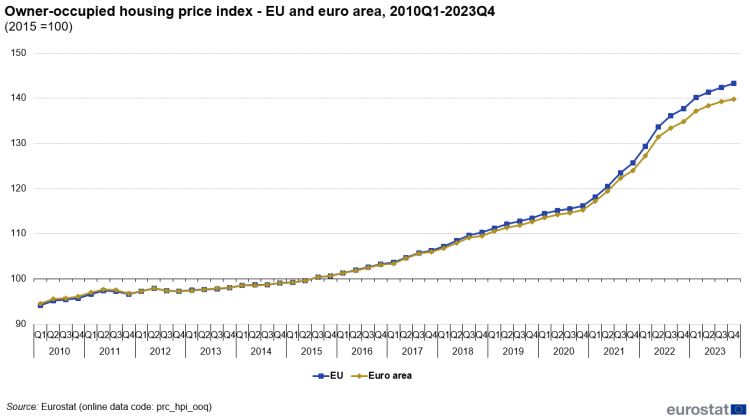
Source: Eurostat (prc_hpi_ooq)
Annual and quarterly rates of change
Figure 2 presents the EU and euro area OOHPI annual rates of change from the first quarter of 2011 to the fourth quarter of 2023. Between 2011 and 2020, the annual rates of change were rather moderate, ranging from -0.3 % to +3.8 % for the EU and from -0.3 % to +3.4 % for the euro area. Starting in the first quarter of 2021, the annual rates of change began to increase exceptionally quickly, reaching a historical high in the second quarter of 2022 (+11.0 % for the EU and +10.0 % for the euro area). In the third quarter of 2022, a period of decrease in the annual rate of change began. In the fourth quarter of 2023, it decreased to +4.1 % for the EU and to +3.7 % for the euro area but was still above values observed before 2021.
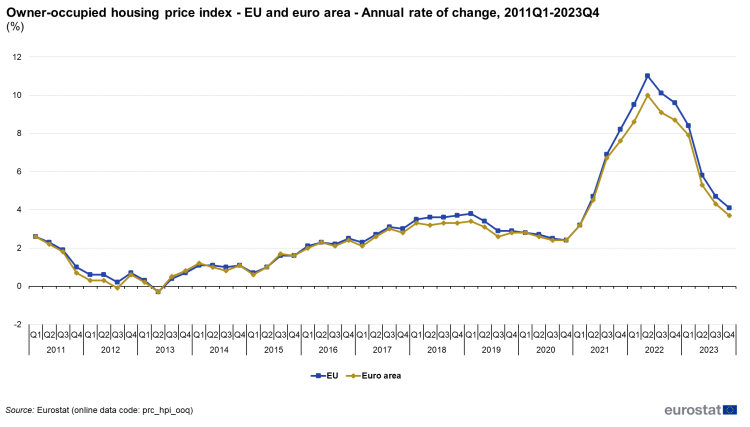
Source: Eurostat (prc_hpi_ooq)
Table 1 presents the quarterly and annual rates of change for the OOHPI for the most recent four quarters. Among the 26 Member States for which data are available, 24 showed an annual increase in owner-occupied housing prices in the fourth quarter of 2023, and two showed an annual decrease. The highest increases were recorded in Romania (+14.5 %), Lithuania (+10.3 %) and Bulgaria (+9.8 %), while the decreases were recorded in Luxembourg (-4.9 %) and Sweden (-1.4 %). Compared with the previous quarter, prices increased in 19 Member States and decreased in seven Member States. The highest increases were recorded in Romania (+4.2 %), Estonia (+3.9 %) and Luxembourg (+3.5 %) while the largest falls were registered in Spain (-0.9 %), Sweden (-0.9%) and Finland (-0.6 %).
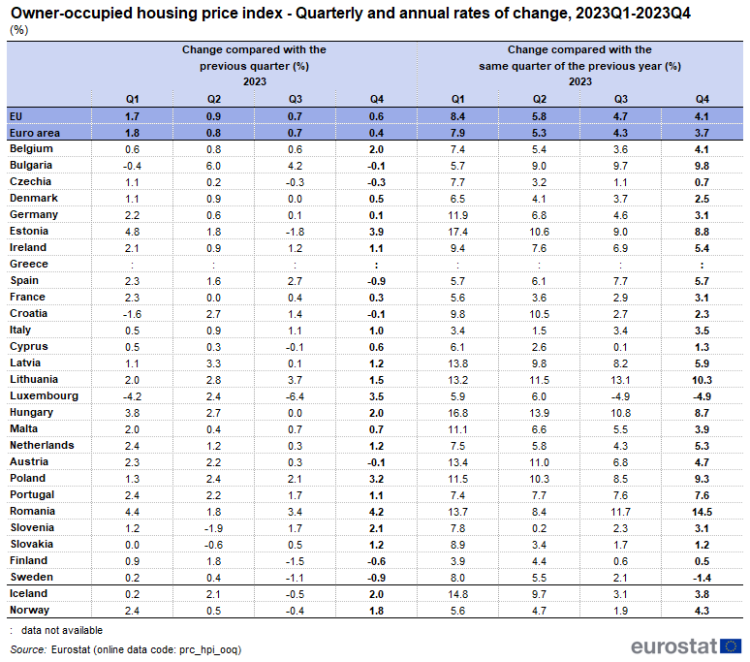
Source: Eurostat (prc_hpi_ooq)
Table 2 presents the quarterly and annual rates of change for the EU OOHPI and its components for the most recent four quarters. Looking at the components of the OOHPI, insurance connected with dwellings had the highest annual rate of change in the fourth quarter of 2023 (+9.1 %), followed by existing dwellings new to households (+8.3 %), other services related to ownership of dwellings (+7.0 %), purchases of newly built dwellings (+5.1 %), major repairs and maintenance (+4.3 %), self-build dwellings and major renovations (+3.9 %), and other services related to the acquisition of dwellings (+0.5 %).
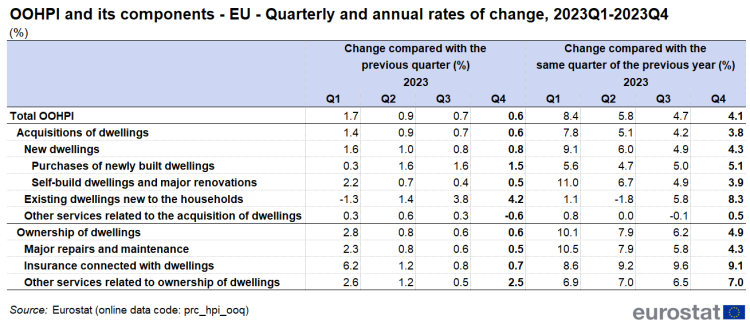
Source: Eurostat (prc_hpi_ooq)
Weights for the calculation of OOHPI
Item weights
The national OOHPIs are calculated on the basis of the price changes and item weights of the owner-occupiers’ housing expenditure categories. The weights of the OOHPI sub-indices are derived from the expenditure of households on any category covered by the OOHPI, expressed as a proportion of the total expenditure on all categories within the coverage of the OOHPI.
Figure 3 illustrates the 2023 item weights for the OOHPI categories for European aggregates and all countries providing OOHPI data.
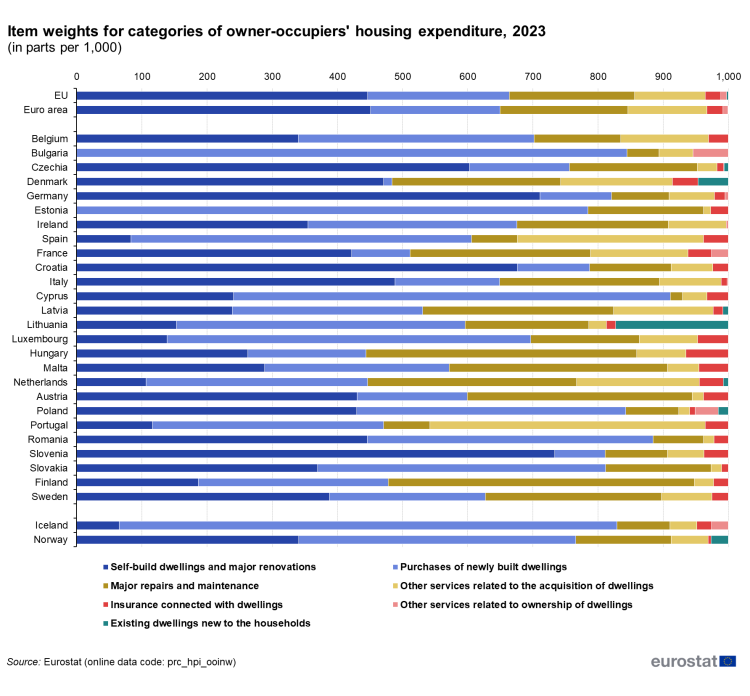
Source: Eurostat (prc_hpi_ooinw)
Table 3 lists the household expenditure categories included in the OOHPI with the respective weights used in the EU and euro area aggregates for 2023. For both European aggregates, the category ‘self-build dwellings and major renovations’ has the highest weight, with 44.6 % and 45.1 % of the total OOH expenditure respectively. Conversely, the category ‘existing dwellings new to households’ has the lowest weight amounting to 0.3 % for the EU and 0.1 % for the euro area. The very low weight of the category ‘existing dwellings new to households’ results from the fact that it relates to household purchases of existing dwellings for their own use, from the non-household sector. Examples of situations that could be covered by this category include a dwelling which was previously owned by a government institution and used as social housing or a dwelling previously belonging to the rental market. Transactions relating to existing dwellings previously own-occupied by households are not covered. This is related to the fact that the index is based on the ‘net’ principle, which means that purchases are accounted for as positive expenditures whereas sales are accounted for as negative expenditures. Consequently, transactions made within the reference population cancel out.
Country weights
The OOHPIs for the euro area and EU aggregates are calculated as weighted averages of the national OOHPIs, using the weights of the countries concerned. The weight of a country is based on the share of a given country’s owner-occupiers’ housing expenditure in total expenditure.
Figure 4 shows the country weights used in 2023 for the calculation of the total OOHPI for the EU aggregate.
Figure 5 shows the country weights used in 2023 for the calculation of the total OOHPI for the euro area aggregate.
Source data for tables and graphs
Data sources
The OOHPI is a price index based on the net acquisitions approach, which measures changes in prices faced by owner-occupiers, i.e. households that live in a dwelling that they own. Both owner-occupiers’ costs related to acquisition of dwellings and costs related to ownership of dwellings are covered.
The data sources used vary depending on the OOHPI category. Some categories are typically based on statistics developed primarily for other purposes.
The OOHPI categories ‘purchases of newly built dwellings’ and ‘existing dwellings new to households’ show conceptual similarities to the house price index (HPI) categories ‘purchases of newly built dwellings’ and ‘purchases of existing dwellings’. The differences between the OOHPI and the HPI categories are as follows:
- dwelling purchases by households for uses other than owner-occupancy (e.g. for rent) are included in the HPI but excluded from the OOHPI;
- existing dwellings transacted between households are included in the HPI but excluded from the OOHPI. This is related to the application of the ‘net’ principle in the case of the OOHPI. For this reason, the weight of the OOHPI category ‘existing dwellings new to households’ is very low or even zero in many countries. In the case of the HPI, the weight of ‘purchases of existing dwellings’ is not only very different from zero but also tends to be higher than the weight for ‘purchases of newly built dwellings’ (the other component of the HPI);
- in the case of the HPI, the land value is included in both weights and prices while in the case of the OOHPI, the land value is excluded from weights but included in prices. Land is excluded from the weights because it is not gross fixed capital formation. It is not excluded from the prices because of the lack of data on land prices.
Despite the differences, in practice the HPI sub-indices are often used as a proxy for the corresponding OOHPI categories. If already available HPIs are not used, then the same data sources and similar calculation methods as those of the HPI are usually applied.
Another OOHPI category that is often based on already available statistics is the category ‘self-build dwellings and major renovations’. In this case, the short-term business statistics for construction (e.g. output price index in construction) may be used.
Figure 6 shows the annual rates of change of the OOHPI for the EU, compared with those of the HPI and the output price index in construction. As the OOHPI is driven largely by price development of the category ‘self-build dwelling and major renovation’, the annual rates of change for the OOHPI and the output price index in construction follow a similar pattern.
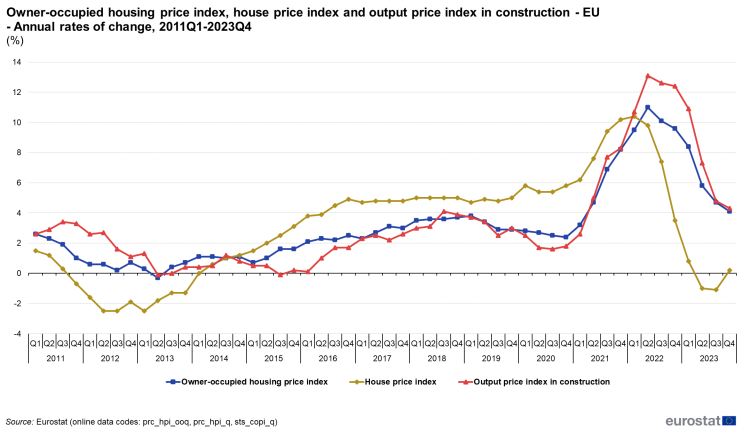
Source: Eurostat (prc_hpi_ooq); (prc_hpi_q); (sts_copi_q)
Price indices for the categories ‘other services related to the acquisition of dwellings’, ‘major repairs and maintenance’, ‘insurance connected with dwellings’ and ‘other services related to ownership of dwellings’ are usually compiled from observed prices that are collected specifically for that purpose. The applicable calculation procedures are similar to those used for compiling the harmonised index of consumer prices (HICP).
National accounts data, complemented with information from other statistical sources, are usually used when deriving the OOHPI weights. Data on gross fixed capital formation is used for categories belonging to ‘Acquisition of dwellings’ and data on intermediate consumption is used for categories belonging to ‘Ownership of dwellings’.
Context
The basic act requiring the compilation of the OOHPI is European Parliament and Council Regulation (EU) 2016/792 of 11 May 2016.
The basic act is implemented by Commission Regulation (EU) 2023/1470 of 17 July 2023.
The OOHPI was developed in connection with the discussion on the measurement of owner-occupied housing in the context of the harmonised index of consumer prices (HICP). As a stand-alone indicator, it measures the cost of owner-occupiers based on the net acquisitions approach.
In 2018, the European Commission published the report on the suitability of the OOH price index for integration into the HICP coverage in which it was assessed that the OOHPI was not suitable for integration into the coverage of the HICP.
In 2021, the European Central Bank (ECB) reviewed its monetary policy strategy and recognized that the inclusion of the costs related to owner-occupied housing in the HICP would be important to better represent inflation. Following the findings from this review, the ECB Governing Council recommended the net acquisitions approach for the inclusion of OOH-related costs in the HICP.
In 2023, Eurostat published the report on owner-occupied housing and the harmonised index of consumer prices, as a response to the ECB’s recommendations.
Direct access to
See also
Main tables
Database
- Housing price statistics (prc_hpi)
- Short-term business statistics (sts_cons)
Dedicated section
Publications
- Housing in Europe – 2023 interactive publication
- Report on owner-occupied housing and the harmonised index of consumer prices
Methodology
- Technical manual on owner-occupied housing and house price indices, 2017
- Owner occupied housing price index (ESMS metadata file — prc_hpi_oo_esms)
- House price and sales index (ESMS metadata file — prc_hpi_inx_esms)
- Short-term business statistics (ESMS metadata file — sts_esms)
Legislation
